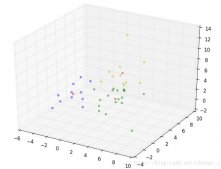單一數(shù)據(jù)讀取方式:
第一種:slice_input_producer()
|
1
2
|
# 返回值可以直接通過 Session.run([images, labels])查看,且第一個參數(shù)必須放在列表中,如[...][images, labels] = tf.train.slice_input_producer([images, labels], num_epochs=None, shuffle=True) |
第二種:string_input_producer()
|
1
2
3
4
5
|
# 需要定義文件讀取器,然后通過讀取器中的 read()方法來獲取數(shù)據(jù)(返回值類型 key,value),再通過 Session.run(value)查看file_queue = tf.train.string_input_producer(filename, num_epochs=None, shuffle=True)reader = tf.WholeFileReader() # 定義文件讀取器key, value = reader.read(file_queue) # key:文件名;value:文件中的內(nèi)容 |
!!!num_epochs=None,不指定迭代次數(shù),這樣文件隊列中元素個數(shù)也不限定(None*數(shù)據(jù)集大小)。
!!!如果它不是None,則此函數(shù)創(chuàng)建本地計數(shù)器 epochs,需要使用local_variables_initializer()初始化局部變量
!!!以上兩種方法都可以生成文件名隊列。
(隨機(jī))批量數(shù)據(jù)讀取方式:
|
1
2
3
|
batchsize=2 # 每次讀取的樣本數(shù)量tf.train.batch(tensors, batch_size=batchsize)tf.train.shuffle_batch(tensors, batch_size=batchsize, capacity=batchsize*10, min_after_dequeue=batchsize*5) # capacity > min_after_dequeue |
!!!以上所有讀取數(shù)據(jù)的方法,在Session.run()之前必須開啟文件隊列線程 tf.train.start_queue_runners()
一、單一數(shù)據(jù)讀取方式
第一種:slice_input_producer()
|
1
|
def slice_input_producer(tensor_list, num_epochs=None, shuffle=True, seed=None, capacity=32, shared_name=None, name=None) |
案例1:
|
1
2
3
4
5
6
7
8
9
10
11
12
13
14
15
16
17
18
19
20
21
22
23
24
25
26
|
import tensorflow as tfimages = ['image1.jpg', 'image2.jpg', 'image3.jpg', 'image4.jpg']labels = [1, 2, 3, 4]# [images, labels] = tf.train.slice_input_producer([images, labels], num_epochs=None, shuffle=True)# 當(dāng)num_epochs=2時,此時文件隊列中只有 2*4=8個樣本,所有在取第9個樣本時會出錯# [images, labels] = tf.train.slice_input_producer([images, labels], num_epochs=2, shuffle=True)data = tf.train.slice_input_producer([images, labels], num_epochs=None, shuffle=True)print(type(data)) # <class 'list'>with tf.Session() as sess: # sess.run(tf.local_variables_initializer()) sess.run(tf.local_variables_initializer()) coord = tf.train.Coordinator() # 線程的協(xié)調(diào)器 threads = tf.train.start_queue_runners(sess, coord) # 開始在圖表中收集隊列運行器 for i in range(10): print(sess.run(data)) coord.request_stop() coord.join(threads)""" |
運行結(jié)果:
[b'image2.jpg', 2]
[b'image1.jpg', 1]
[b'image3.jpg', 3]
[b'image4.jpg', 4]
[b'image2.jpg', 2]
[b'image1.jpg', 1]
[b'image3.jpg', 3]
[b'image4.jpg', 4]
[b'image2.jpg', 2]
[b'image3.jpg', 3]
"""
!!!slice_input_producer() 中的第一個參數(shù)需要放在一個列表中,列表中的每個元素可以是 List 或 Tensor,如 [images,labels],
!!!num_epochs設(shè)置
第二種:string_input_producer()
|
1
|
def string_input_producer(string_tensor, num_epochs=None, shuffle=True, seed=None, capacity=32, shared_name=None, name=None, cancel_op=None) |
文件讀取器
不同類型的文件對應(yīng)不同的文件讀取器,我們稱為 reader對象;
該對象的 read 方法自動讀取文件,并創(chuàng)建數(shù)據(jù)隊列,輸出key/文件名,value/文件內(nèi)容;
|
1
2
3
4
5
|
reader = tf.TextLineReader() ### 一行一行讀取,適用于所有文本文件reader = tf.TFRecordReader() ### A Reader that outputs the records from a TFRecords filereader = tf.WholeFileReader() ### 一次讀取整個文件,適用圖片 |
案例2:讀取csv文件
|
1
2
3
4
5
6
7
8
9
10
11
12
13
14
15
16
17
18
19
20
21
22
23
24
25
26
27
28
29
30
31
32
33
34
35
36
37
38
39
40
41
42
43
44
45
46
|
import tensorflow as tffilename = ['data/A.csv', 'data/B.csv', 'data/C.csv']file_queue = tf.train.string_input_producer(filename, shuffle=True, num_epochs=2) # 生成文件名隊列reader = tf.WholeFileReader() # 定義文件讀取器(一次讀取整個文件)# reader = tf.TextLineReader() # 定義文件讀取器(一行一行的讀)key, value = reader.read(file_queue) # key:文件名;value:文件中的內(nèi)容print(type(file_queue))init = [tf.global_variables_initializer(), tf.local_variables_initializer()]with tf.Session() as sess: sess.run(init) coord = tf.train.Coordinator() threads = tf.train.start_queue_runners(sess=sess, coord=coord) try: while not coord.should_stop(): for i in range(6): print(sess.run([key, value])) break except tf.errors.OutOfRangeError: print('read done') finally: coord.request_stop() coord.join(threads)"""reader = tf.WholeFileReader() # 定義文件讀取器(一次讀取整個文件)運行結(jié)果:[b'data/C.csv', b'7.jpg,7\n8.jpg,8\n9.jpg,9\n'][b'data/B.csv', b'4.jpg,4\n5.jpg,5\n6.jpg,6\n'][b'data/A.csv', b'1.jpg,1\n2.jpg,2\n3.jpg,3\n'][b'data/A.csv', b'1.jpg,1\n2.jpg,2\n3.jpg,3\n'][b'data/B.csv', b'4.jpg,4\n5.jpg,5\n6.jpg,6\n'][b'data/C.csv', b'7.jpg,7\n8.jpg,8\n9.jpg,9\n']""""""reader = tf.TextLineReader() # 定義文件讀取器(一行一行的讀)運行結(jié)果:[b'data/B.csv:1', b'4.jpg,4'][b'data/B.csv:2', b'5.jpg,5'][b'data/B.csv:3', b'6.jpg,6'][b'data/C.csv:1', b'7.jpg,7'][b'data/C.csv:2', b'8.jpg,8'][b'data/C.csv:3', b'9.jpg,9']""" |
案例3:讀取圖片(每次讀取全部圖片內(nèi)容,不是一行一行)
|
1
2
3
4
5
6
7
8
9
10
11
12
13
14
15
16
17
18
|
import tensorflow as tffilename = ['1.jpg', '2.jpg']filename_queue = tf.train.string_input_producer(filename, shuffle=False, num_epochs=1)reader = tf.WholeFileReader() # 文件讀取器key, value = reader.read(filename_queue) # 讀取文件 key:文件名;value:圖片數(shù)據(jù),byteswith tf.Session() as sess: tf.local_variables_initializer().run() coord = tf.train.Coordinator() # 線程的協(xié)調(diào)器 threads = tf.train.start_queue_runners(sess, coord) for i in range(filename.__len__()): image_data = sess.run(value) with open('img_%d.jpg' % i, 'wb') as f: f.write(image_data) coord.request_stop() coord.join(threads) |
二、(隨機(jī))批量數(shù)據(jù)讀取方式:
功能:shuffle_batch() 和 batch() 這兩個API都是從文件隊列中批量獲取數(shù)據(jù),使用方式類似;
案例4:slice_input_producer() 與 batch()
|
1
2
3
4
5
6
7
8
9
10
11
12
13
14
15
16
17
18
19
20
21
22
23
24
25
26
27
|
import tensorflow as tfimport numpy as npimages = np.arange(20).reshape([10, 2])label = np.asarray(range(0, 10))images = tf.cast(images, tf.float32) # 可以注釋掉,不影響運行結(jié)果label = tf.cast(label, tf.int32) # 可以注釋掉,不影響運行結(jié)果batchsize = 6 # 每次獲取元素的數(shù)量input_queue = tf.train.slice_input_producer([images, label], num_epochs=None, shuffle=False)image_batch, label_batch = tf.train.batch(input_queue, batch_size=batchsize)# 隨機(jī)獲取 batchsize個元素,其中,capacity:隊列容量,這個參數(shù)一定要比 min_after_dequeue 大# image_batch, label_batch = tf.train.shuffle_batch(input_queue, batch_size=batchsize, capacity=64, min_after_dequeue=10)with tf.Session() as sess: coord = tf.train.Coordinator() # 線程的協(xié)調(diào)器 threads = tf.train.start_queue_runners(sess, coord) # 開始在圖表中收集隊列運行器 for cnt in range(2): print("第{}次獲取數(shù)據(jù),每次batch={}...".format(cnt+1, batchsize)) image_batch_v, label_batch_v = sess.run([image_batch, label_batch]) print(image_batch_v, label_batch_v, label_batch_v.__len__()) coord.request_stop() coord.join(threads)""" |
運行結(jié)果:
第1次獲取數(shù)據(jù),每次batch=6...
[[ 0. 1.]
[ 2. 3.]
[ 4. 5.]
[ 6. 7.]
[ 8. 9.]
[10. 11.]] [0 1 2 3 4 5] 6
第2次獲取數(shù)據(jù),每次batch=6...
[[12. 13.]
[14. 15.]
[16. 17.]
[18. 19.]
[ 0. 1.]
[ 2. 3.]] [6 7 8 9 0 1] 6
"""
案例5:從本地批量的讀取圖片 --- string_input_producer() 與 batch()
|
1
2
3
4
5
6
7
8
9
10
11
12
13
14
15
16
17
18
19
20
21
22
23
24
25
26
27
28
29
30
31
32
33
34
35
36
37
38
39
40
41
42
43
44
45
46
47
48
49
50
51
52
53
54
55
56
57
58
59
60
61
62
63
64
65
66
67
68
69
70
71
72
73
74
75
76
77
78
79
80
81
82
83
84
85
|
import tensorflow as tfimport globimport cv2 as cvdef read_imgs(filename, picture_format, input_image_shape, batch_size=): """ 從本地批量的讀取圖片 :param filename: 圖片路徑(包括圖片的文件名),[] :param picture_format: 圖片的格式,如 bmp,jpg,png等; string :param input_image_shape: 輸入圖像的大小; (h,w,c)或[] :param batch_size: 每次從文件隊列中加載圖片的數(shù)量; int :return: batch_size張圖片數(shù)據(jù), Tensor """ global new_img # 創(chuàng)建文件隊列 file_queue = tf.train.string_input_producer(filename, num_epochs=1, shuffle=True) # 創(chuàng)建文件讀取器 reader = tf.WholeFileReader() # 讀取文件隊列中的文件 _, img_bytes = reader.read(file_queue) # print(img_bytes) # Tensor("ReaderReadV2_19:1", shape=(), dtype=string) # 對圖片進(jìn)行解碼 if picture_format == ".bmp": new_img = tf.image.decode_bmp(img_bytes, channels=1) elif picture_format == ".jpg": new_img = tf.image.decode_jpeg(img_bytes, channels=3) else: pass # 重新設(shè)置圖片的大小 # new_img = tf.image.resize_images(new_img, input_image_shape) new_img = tf.reshape(new_img, input_image_shape) # 設(shè)置圖片的數(shù)據(jù)類型 new_img = tf.image.convert_image_dtype(new_img, tf.uint) # return new_img return tf.train.batch([new_img], batch_size)def main(): image_path = glob.glob(r'F:\demo\FaceRecognition\人臉庫\ORL\*.bmp') image_batch = read_imgs(image_path, ".bmp", (112, 92, 1), 5) print(type(image_batch)) # image_path = glob.glob(r'.\*.jpg') # image_batch = read_imgs(image_path, ".jpg", (313, 500, 3), 1) sess = tf.Session() sess.run(tf.local_variables_initializer()) tf.train.start_queue_runners(sess=sess) image_batch = sess.run(image_batch) print(type(image_batch)) # <class 'numpy.ndarray'> for i in range(image_batch.__len__()): cv.imshow("win_"+str(i), image_batch[i]) cv.waitKey() cv.destroyAllWindows()def start(): image_path = glob.glob(r'F:\demo\FaceRecognition\人臉庫\ORL\*.bmp') image_batch = read_imgs(image_path, ".bmp", (112, 92, 1), 5) print(type(image_batch)) # <class 'tensorflow.python.framework.ops.Tensor'> with tf.Session() as sess: sess.run(tf.local_variables_initializer()) coord = tf.train.Coordinator() # 線程的協(xié)調(diào)器 threads = tf.train.start_queue_runners(sess, coord) # 開始在圖表中收集隊列運行器 image_batch = sess.run(image_batch) print(type(image_batch)) # <class 'numpy.ndarray'> for i in range(image_batch.__len__()): cv.imshow("win_"+str(i), image_batch[i]) cv.waitKey() cv.destroyAllWindows() # 若使用 with 方式打開 Session,且沒加如下行語句,則會出錯 # ERROR:tensorflow:Exception in QueueRunner: Enqueue operation was cancelled; # 原因:文件隊列線程還處于工作狀態(tài)(隊列中還有圖片數(shù)據(jù)),而加載完batch_size張圖片會話就會自動關(guān)閉,同時關(guān)閉文件隊列線程 coord.request_stop() coord.join(threads)if __name__ == "__main__": # main() start() |
案列6:TFRecord文件打包與讀取
TFRecord文件打包案列
|
1
2
3
4
5
6
7
8
9
10
11
12
13
14
15
16
17
18
19
20
21
22
23
24
25
26
27
28
29
30
31
32
33
34
35
36
37
38
39
40
41
42
43
44
45
46
47
48
49
50
51
52
53
54
55
56
|
def write_TFRecord(filename, data, labels, is_shuffler=True): """ 將數(shù)據(jù)打包成TFRecord格式 :param filename: 打包后路徑名,默認(rèn)在工程目錄下創(chuàng)建該文件;String :param data: 需要打包的文件路徑名;list :param labels: 對應(yīng)文件的標(biāo)簽;list :param is_shuffler:是否隨機(jī)初始化打包后的數(shù)據(jù),默認(rèn):True;Bool :return: None """ im_data = list(data) im_labels = list(labels) index = [i for i in range(im_data.__len__())] if is_shuffler: np.random.shuffle(index) # 創(chuàng)建寫入器,然后使用該對象寫入樣本example writer = tf.python_io.TFRecordWriter(filename) for i in range(im_data.__len__()): im_d = im_data[index[i]] # im_d:存放著第index[i]張圖片的路徑信息 im_l = im_labels[index[i]] # im_l:存放著對應(yīng)圖片的標(biāo)簽信息 # # 獲取當(dāng)前的圖片數(shù)據(jù) 方式一: # data = cv2.imread(im_d) # # 創(chuàng)建樣本 # ex = tf.train.Example( # features=tf.train.Features( # feature={ # "image": tf.train.Feature( # bytes_list=tf.train.BytesList( # value=[data.tobytes()])), # 需要打包成bytes類型 # "label": tf.train.Feature( # int64_list=tf.train.Int64List( # value=[im_l])), # } # ) # ) # 獲取當(dāng)前的圖片數(shù)據(jù) 方式二:相對于方式一,打包文件占用空間小了一半多 data = tf.gfile.FastGFile(im_d, "rb").read() ex = tf.train.Example( features=tf.train.Features( feature={ "image": tf.train.Feature( bytes_list=tf.train.BytesList( value=[data])), # 此時的data已經(jīng)是bytes類型 "label": tf.train.Feature( int_list=tf.train.IntList( value=[im_l])), } ) ) # 寫入將序列化之后的樣本 writer.write(ex.SerializeToString()) # 關(guān)閉寫入器 writer.close() |
TFReord文件的讀取案列
|
1
2
3
4
5
6
7
8
9
10
11
12
13
14
15
16
17
18
19
20
21
22
23
24
25
26
27
28
29
30
31
32
33
34
35
36
37
38
39
40
41
42
43
44
45
46
47
48
49
50
51
52
53
54
55
56
|
import tensorflow as tfimport cv2def read_TFRecord(file_list, batch_size=): """ 讀取TFRecord文件 :param file_list: 存放TFRecord的文件名,List :param batch_size: 每次讀取圖片的數(shù)量 :return: 解析后圖片及對應(yīng)的標(biāo)簽 """ file_queue = tf.train.string_input_producer(file_list, num_epochs=None, shuffle=True) reader = tf.TFRecordReader() _, ex = reader.read(file_queue) batch = tf.train.shuffle_batch([ex], batch_size, capacity=batch_size * 10, min_after_dequeue=batch_size * 5) feature = { 'image': tf.FixedLenFeature([], tf.string), 'label': tf.FixedLenFeature([], tf.int64) } example = tf.parse_example(batch, features=feature) images = tf.decode_raw(example['image'], tf.uint) images = tf.reshape(images, [-1, 32, 32, 3]) return images, example['label']def main(): # filelist = ['data/train.tfrecord'] filelist = ['data/test.tfrecord'] images, labels = read_TFRecord(filelist, 2) with tf.Session() as sess: sess.run(tf.local_variables_initializer()) coord = tf.train.Coordinator() threads = tf.train.start_queue_runners(sess=sess, coord=coord) try: while not coord.should_stop(): for i in range(): image_bth, _ = sess.run([images, labels]) print(_) cv2.imshow("image_0", image_bth[0]) cv2.imshow("image_1", image_bth[1]) break except tf.errors.OutOfRangeError: print('read done') finally: coord.request_stop() coord.join(threads) cv2.waitKey(0) cv2.destroyAllWindows()if __name__ == "__main__": main() |
到此這篇關(guān)于Tensorflow中批量讀取數(shù)據(jù)的案列分析及TFRecord文件的打包與讀取的文章就介紹到這了,更多相關(guān)Tensorflow TFRecord打包與讀取內(nèi)容請搜索服務(wù)器之家以前的文章或繼續(xù)瀏覽下面的相關(guān)文章希望大家以后多多支持服務(wù)器之家!
原文鏈接:https://www.cnblogs.com/nbk-zyc/p/13159986.html












